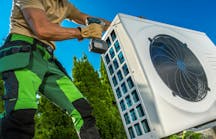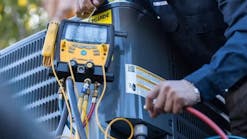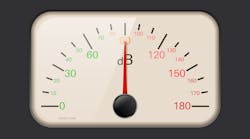Thanks to many of you for responding about the HotMail article that appeared in Contracting Business magazine last January: How to Reduce Register and Grille Noise.
Several of you asked for specific sound measurement instructions. So let’s take a look at how to measure and solve HVAC system sound level problems.
An Adequate Test Procedure
Ninety-five percent of technicians and salespeople overlook HVAC sound issues. Any solutions you provide will be greatly appreciated by customers. The test procedure offered here is simple, basic, and will do the job for you.
Some problems may be outside the scope of the basic test and diagnostic steps presented in this article. Professional sound and vibration services are available at 10-20 times your normal cost to test, diagnose, and repair HVAC noise problems.
Typical HVAC Problems and Solutions
Ideally, when an HVAC system is operating, sound levels are barely detectable by occupants. When noise levels don’t fade into the background or become white noise that can be easily dismissed, the opportunity to solve these problems presents itself.
Air velocity noise may be the source of your most common complaint. This noise occurs in a system when air velocity is high where air enters or exits a system.
One classic problem is excessive noise through a single return grille. Louvers on a typically stamped face return grille can reduce the free area for airflow by 50%. System airflow squeezing through the louvers generates excessive noise and subsequent harmonics set off vibrations. When this happens, the noise becomes irritating.
The solution for loud return grilles is to add another return duct run from the equipment to an additional return grille. This reduces airflow through both return grilles to acceptable levels.
The solution for loud return grilles is to add another return duct run from the equipment to an additional return grille. This reduces airflow through both return grilles to acceptable levels.
Supply registers howl when a tight elbow funnels air into one side of an outlet. While total airflow through the register may meet design, the air following the outside of the elbow into one small area of the grille creates high air velocity. This excessive velocity drastically increases noise levels. Straighten the duct entering the register and air velocity noise decreases.
Duct system noises may often be a result of loose duct material flapping in the wind. A loose air volume damper vibrating or metal duct transmitting fan vibration noise into the building structure at a point of contact may also be a culprit. Screws can also work lose at registers, creating a vibration. Find the problem and make needed mechanical repairs.
Excessive equipment sound can be transmitted through a building and create an ongoing annoyance requiring raising the TV volume or increasing conversation levels. It may even cause a reduction in room use or not using the heating or cooling system when the room is occupied. Equipment vibration isolators are inexpensive and easy to install.
While people learn to live around these problems, they are delighted to find out you can test, diagnose and remove those ever-present noise annoyances from their lives. You will find them willing to pay handsomely for your solutions.
Test Instruments
Basic sound meters that measure sound levels discernable by human ears are relatively inexpensive. Apps using the functions of your mobile phone are available for little or no cost that will do the job for HVAC system testing. Many apps have good visual screen displays.
While people learn to live around these problems, they are delighted to find out you can test, diagnose and remove those ever-present noise annoyances from their lives.
Some techs claim they find more credibility using a hand-held instrument. Either way, the choice is yours. Consider cost, quality, and how the instrument presents data so your customer can see and understand as you test their system together.
Assure the instrument you choose uses the A-Weighted scale. This scale measures sound levels in the range of the human ear and is easy to understand. A-weighted measurements are expressed as dBA. The dB represents decibels and the A indicates the A-Weighted scale. We’ll keep it simple and use the term dB throughout this article.
Most of us can detect sound at 20 dB. A usual response to conversations lower than 20 bB may be “What’d you say?” Ear pain begins at about 120 dB. This is the “You kids turn that music down!” sound level. Another useful fact to help understand sound measurement is that the sound levels we hear, double every 10 dB.
Improvement is measured by documenting the dB levels before and after you solve the problem. Remember, when you reduce the sound level by 10 dB, noise is reduced by 50%.
Sound Level Test Procedure
The most important sound level value you can use to assess your customer’s needs is their opinion of the irritating sound. A sound meter quantifies the sound level and assigns a measured decibel value to it.
Step one – Invite your customer to join in the testing. Prepare to measure and record ambient noise levels in the room containing the problem by turning off the HVAC system. Aim your sound meter in the direction your customer is facing. Invite your customer to listen and give an OK sign when the room is at its typical sound level.
Measure and record the ambient room sound level with the system off. This dB reading is the room baseline sound level.
Step two - Turn on the air conditioning or heating system and allow it to ramp up to full volume. Hold your meter three feet from the noise source identified by your customer. Hold the meter at a 45-degree angle to the objectionable noise. Measure and record the ambient room sound level with the system operating.
Step three - Subtract the ambient room sound level in dB with the system off, from the room sound level in dB with the system on. The difference is the level of annoying sound produced by the HVAC system.
Step four - Isolate the source of the sound by using your sound meter like a noise sniffer. Start at the center of the room and point your sound meter in the direction of the bothersome noise. Move toward the source of the sound. The closer you and your customer get to the sound source, the higher the dB level. Eureka, you’ve found it.
Step five - Assess the cause of the annoying sound by inspecting, testing, and evaluating the system. Use the guidelines in the Typical HVAC Problems and Solutions section of this article. Then identify and price a scope of work, present the solution to your customer, and have them approve the work.
Step six - Complete the repairs. Measure the improvement in the sound level using steps one through three again. Invite your customer to witness and verify the noise reduction. Finally, get paid and drive off into the sunset knowing you exceeded your customers’ expectations and provided a solution far beyond the reach of others in the industry.
Add HVAC system sound level testing to your list of skills. A sound meter app is free. Download it and give it a try at home. Soon, you’ll begin to notice sound problems in systems you deal with. Then you’ll be able to discuss your customers’ noise problems and offer unique solutions. There’s nothing like solving problems others can’t.
Rob “Doc” Falke serves the industry as president of National Comfort Institute, Inc., an HVAC-based training company and membership organization. If you're an HVAC contractor or technician interested in a free test sound level test procedure, Doc at [email protected] or call him at 800-633-7058. Go to NCI’s website at nationalcomfortinstitute.com for free information, articles, and download









